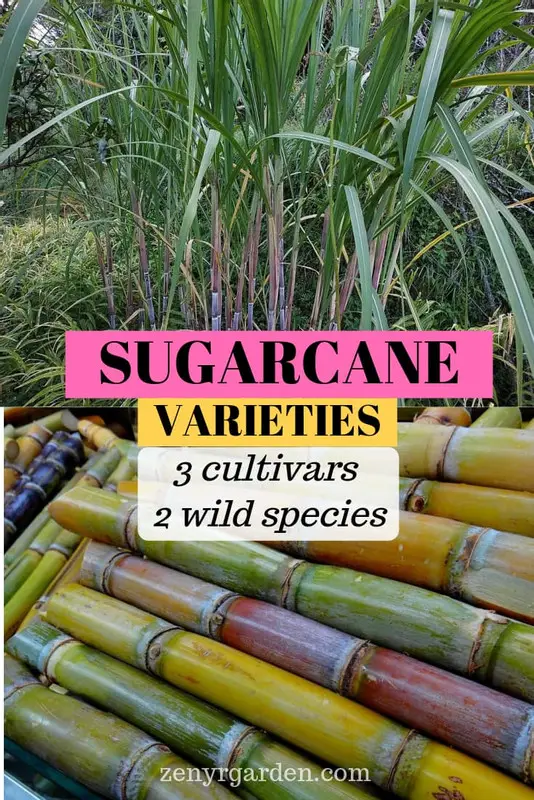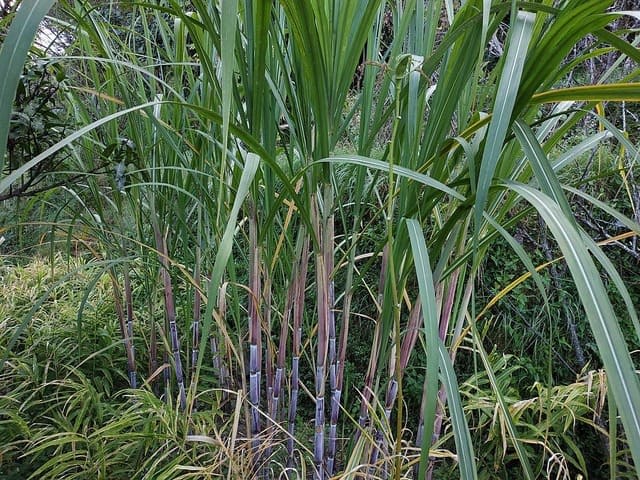Sugarcane belongs to the Saccharum genus. Within this classification, there are 5 sugarcane varieties–three are cultivars and the other two are wild varieties.
Let's check them out below.
Saccharum officinarum (cultivar)
Saccharum officinarum, also known commonly as noble cane, is suitable for growing in tropical climates. People usually grow this variety to eat fresh or to press out the juice. The stem is thick with soft inside flesh and not a lot fiber ratio. The amount of sugarcane juice is high with a high sugar level.
On the outside bark, this variety can be green, yellow, dark red or purple. It flowers very little and sometimes produces no flowers at all. In good soil condition, S. officinarum can produce such high yield that few other varieties can equate.
The Officinarum is not allergic to sugarcane smut disease. But overall, its resistance to pests is quite weak–especially so to root-borne diseases like mosaic and streak. This is why growers hybridize other varieties with this one to improve the resistance while still obtaining high sweet yields.
Some natural S. Officinarum varieties are:
- Cristalina (also made into a spirit)
- Light Preanger
- Badila
- Eidji
- Black Tanna
- Otaheite
- Loethers
- Yellow Caledonia
- Cheribon
- Horne
Saccharum barberi (cultivar)
S. barberi is a variety originated from the Northern Indian region. It is suitable for growing in sub-tropical areas. This one has a lower sugar content compared to the S. officinarum.
The overall plant is small with cylindrical node of green or white color. The inside flesh of S. barberi has lots of fiber. The width of the blades (or the leaves) is quite thin. Overall, this cultivar has very good viability. It can resist pests and diseases quite well.
Some common S. barberi varieties names are:
- Chume
- Kansar
- Sarvathia
- Manga
- Mungo
- Katha
Saccharum sinense (cultivar)
S. sinense, aka the Chinese sugarcane, are suited to the tropics and sub-tropics. It has great viability, matures early, contains an average level of sucrose and high fiber content. The stem of the plant is small with nodes that look like the shape of a yarn spool.
The outer bark of this cultivar is green with a hint of bronze covered with white powdery sap between each node. Its leaves are narrow and the blooming rate is low. S. sinense can resist mosaic disease, but it is susceptible to smut, streak and sugarcane red dot disease.
Some S. sinense common names are:
- Agaul
- Kavangire
- Merthi
- Uba
- Oshima
- Yon-tan-san
- Cayana
- Toucha
- CH.64/21, Cuban Selection
Saccharum spontaneum (wild specie)
Out of the two wild sugarcane species, S. spontaneum is the only variety that is highly resistant to mosaic disease, root-rotting disease and other sugarcane pests.
However, because of its extremely high fiber content and low sugar count, this variety attracts little commercial interest per se.
People mostly use this 'wild blood' as the starting gene to hybridize other cultivars, giving hybrid varieties great viability, wide adaptability, higher yield and strong resistance to diseases.
A cross between S. officinarum x S. spontaneum produces hybrids that can resist mosaic and streak:
- Kassoer (S. spontaneum Java)
- Toledo (S. spontaneum Celebes)
Saccharum robustum (wild specie)
The S. robustum variety has big stem, long node and low sugar content. Jeswiet first discovered this wild specie in New Guinea in 1929. The S. robustum has strong viability, good yield and do produce flowers.
As the stem of S. robustum is very thick, it can withstand strong wind or even stormy weathers with little chances of breaking. Thanks to this characteristic, this wild specie can resist against pests that penetrate deep through the bark into the stem. An example is the ratoon stunting disease.
According to Carassi, the S. robustum and the Erianthus maxinus have joined hands in the development of the noble cane (S. officinarum) that we saw earlier. This can be seen by observing the shape or the tiny tissue of the noble cane.
Responses to Readers' Questions
Which sugarcane can affect human being to diaholle
--> Thanks for your question. I'm not sure I understand what you mean. What is diaholle? Could you please rephrase the question?
This variety B47419 is from Where?
--> Hi, thanks for your question. According to an info source (https://www.seedportal.org.ng/variety.php?keyword=&category=&varid=451&cropid=13&task=view), the B47419 variety's origin/source is from Barbados.
Share or pin this post!


